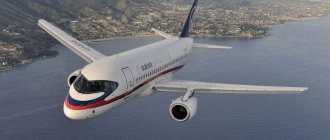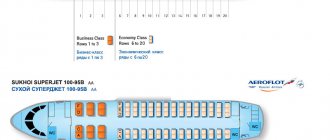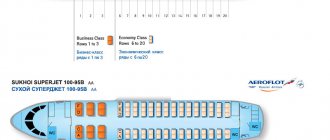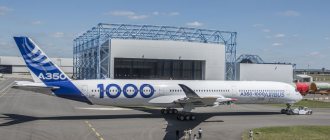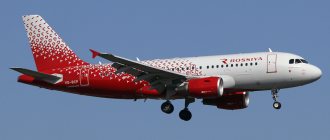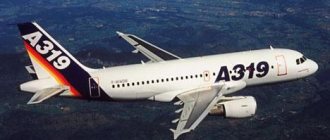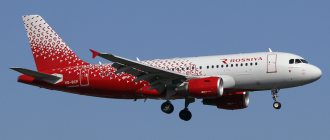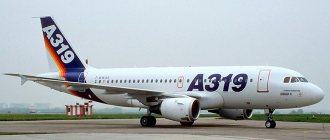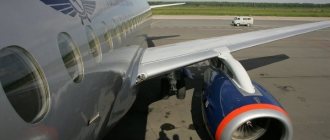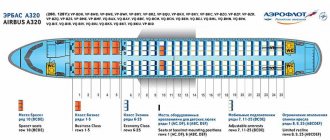The SSJ-100 is a domestically produced short-haul aircraft. As of today (August 2018), the airline’s fleet includes 45 units of this type.
SSJ-100 tail numbers: RA-89014, RA-89015, RA-89017, RA-89022, RA-89023, RA-89024, RA-89025, RA-89026, RA-89027, RA-89028, RA-89032, RA-89041, RA-89042, RA-89043, RA-89044, RA-89045, RA-89046, RA-89047, RA-89051, RA-89052, RA-89056, RA-89057, RA-89058, RA- 89059, RA-89060, RA-89061, RA-89062, RA-89063, RA-89064, RA-89065, RA-89097, RA-89098, RA-89099, RA-89100, RA-89101, RA-89102, RA-89103, RA-89104, RA-89105, RA-89106, RA-89107, RA-89108, RA-89111, RA-89112, RA-89113.
Names of the liners: V. Sysovsky, SKYTEAM, P. Khmelnitsky, I. Orlovets, P. Mikhailov, D. Ezersky, D. Barilov, Kh. Tskhovrebov, G. Benkunsky, V. Borisov, B. Bugaev, M. Vodopyanov, E Barabash, B. Welling, A. Vitkovsky, I. Voedilo, D. Glinka, A. Gruzdin, M. Efimov, B. Lakhtin, P. Nesterov, N. Novikov, N. Rubtsov, Yu. Ovsyannikov, A. Semenkov , B. Osipov, I. Ryshkov, K. Sapelkin, N. Safronnikov, M. Stupishin, P. Derunov, M. Karim, M. Lomonosov, Y. Israel, K. Kuliev, V. Bykov, V. Astafiev, V Zhukovsky, V. Kaverin, V. Aksenov, L. Kassil, S. Dezhnev, I. Kozhedub, V. Kokkinaki, A. Maresyev.
And cheap air tickets for all airlines at this link
The aircraft used have a two-class cabin layout:
- The business class cabin accommodates 12 seats in a 2x2 configuration.
- The economy class cabin has 75 seats in a 2x3 layout.
Description and diagram of the Sukhoi Superjet 100 aircraft
Sukhoi Superjet 100 aircraft are equipped with comfortable economy and business class cabins. There is a fairly large gap between the seats, allowing passengers to sit comfortably during the flight. Above the seats there are shelves for personal luggage that can support up to 50 kg of weight.
General characteristics of the SSJ 100 model:
- body length – 30 m;
- cruising speed – 830 km/h;
- max speed – 860 km/h;
- flight range – 3050 km.
SuperJet 100-95
The salon is designed to seat 87 people. In the comfortable business class there are 12 seats in three rows, the seat layout is 2x2. There is a bathroom for business class passengers in the bow of the aircraft.
Economy class occupies rows 6-20. The seats are arranged in two rows in a 2x3 layout. The toilet room and technical rooms are located at the rear of the aircraft behind the last rows.
SuperJet 100-95LR
The aircraft has a one-class cabin layout for 103 and 100 passenger seats. The seats are arranged in two rows (2x3). In the forward compartment there is a galley and a bathroom. Another toilet room is located at the rear of the aircraft.
Project development history
The prerequisite for creating our own short-haul airliner in Russia arose at the end of the last century. The largest aircraft construction companies, Boeing and Airbus, occupied the market segment for the creation of ships with a capacity of more than 150 passengers. It was necessary to create a project that would be modern, high-quality, and provide short-haul transport. This was the process of creating the Sukhoi Superjet Su 100-95B aircraft.
In the early 2000s, Brazilian and Canadian airliners appeared in this niche, but Sukhoi still had advantages that qualitatively distinguished it from competitors’ products. Analysts came to the conclusion that these companies will not be able to meet airline requests on their own. Demand significantly exceeded supply.
The Russian aircraft industry found itself in a crisis; it only shadowed the past successes of the Soviet Union. Airplanes of the Tupolev and Yak-42 brands were once masterpieces of engineering, but at the beginning of the 21st century they ceased to meet European standards. The noise level of these models forced Russian airlines to urgently update their fleet in order to continue active operations and provide air transportation. This restriction was introduced in 2002 by the European Union. Among other things, the high fuel consumption of older aircraft provoked higher costs; against their background, Boeing and Airbus airliners seemed the only option. Intensive purchases of used imported aircraft began.
Where is the best place to sit in the SSJ 100?
For a comfortable flight over any distance, passengers are recommended to choose the best seats on the plane. Many airlines offer a paid service for choosing a seat in the cabin. You can reserve a comfortable seat for accommodation at the stage of booking your air ticket.
When purchasing business class tickets on a Sukhoi Superjet 100 aircraft, passengers can choose a seat in the cabin for free, taking into account their personal preferences. In this class of service, all seats are characterized by the highest level of comfort. If a traveler wants to watch beautiful views from a flying height, it is better for him to book a seat near the window. Aisle seats allow you to move freely around the cabin without disturbing the neighbor sitting next to you.
Economy class also has better seating options. The most comfortable seats with increased legroom are located in row 6 (first row of economy class).
In the middle part of the cabin, from rows 9 to 15, the window seats have a drawback - the beautiful view from the window is obscured by the airplane's wings. We also suggest that you familiarize yourself with how to choose the right comfortable seat in the aircraft cabin.
The most uncomfortable seats are in the last row of economy class.
Disadvantage of row 20 seats:
- blocked backrest lowering mechanism;
- close location to the toilet room.
In addition, in the last rows of the cabin you can hear more engine noise, which also does not allow you to rest comfortably during the flight.
Other useful articles:
Useful tips for those who are flying on a plane for the first time Advantages of buying a plane ticket online How to buy cheap plane tickets - detailed instructions All types of plane flights: direct and with transfers How to buy a subsidized plane ticket in 2018-2019 New rules for permissible weight baggage on the plane and hand luggage How to find and buy a plane ticket at an erroneous fare What are promotional air tickets and how to look for them Baggage insurance during a flight: types, cost, insured event
Operators
From 2011 to August 2022, 167 examples of the SSJ100 were produced. According to open sources, Superjet is used by the following Russian airlines, organizations and departments:
- “Aeroflot” – 50 units out of 150 ordered were received;
- “Yamal” – 15 units out of 25 ordered are in operation;
- Gazprom Avia – ten units in operation;
- “Azimuth” – eight units in operation;
- “IrAero” – eight units in operation;
- “Yakutia” – five units in operation;
- “RusJet” – one copy is in operation;
- FSBI “Special Flight Detachment “Russia” - two units in operation;
- Ministry of Emergency Situations of Russia - two of the eight ordered units are in operation;
- Ministry of Internal Affairs of Russia - one copy is in operation.
The largest foreign operator of this type of aircraft is the Mexican air carrier Interjet, which has received 22 of the 30 aircraft ordered. The Irish airline CityJet signed a contract for 15 copies; in total, since 2016, it has received seven aircraft (of which four operated under the flag of the Belgian Brussels Airlines), but as of February 2022 it is not operating them. Swiss Comlux ordered two aircraft of the Sukhoi Business Jet modification, one of them was received. In 2011, 12 examples of the SSJ100 were ordered by Indonesian carrier Sky Aviation, but the company encountered financial problems and two of the delivered aircraft are not in use. Three aircraft in business configuration were received by the Thai Air Force, another is operated by the Border Guard Service of Kazakhstan. In September 2022, Zambia ordered one SSJ100 in the VIP version.
On February 28, 2022, Sukhoi Civil Aircraft announced the signing of a contract with the Thai company Kom Airlines for the supply of six SSJ100s in 2019-2020.
Features, Benefits and Issues
The aircraft is equipped with two Russian-French SaM146 engines. This is a low-wing aircraft with a normal aerodynamic design. Modern industrial alloys and materials were used in the construction of the aircraft. Thus, composites were used in the construction of the wing and fairings. Protection against touching the runway during takeoff has been implemented.
The Superjet 100 was the first Russian passenger aircraft to be equipped with a side control stick, instead of a steering wheel. During development, the wishes of potential customers were taken into account, and specific design problems were solved.
What is attractive to jet operators is:
- Compliance with international standards
- The ability to land at any airfield, regardless of the weather
- Modern electronic flight control system
- Aerodynamic, weight and economic efficiency
- Increased range on selected models of the family
The domestic aircraft is designed to operate both short-haul routes and medium-haul routes. The multi-component security system makes the car reliable (unprecedented 98% at the end of 2017).
The cost of producing the aircraft is relatively low, which makes it competitive among aircraft in its segment.
The safe flights that the Sukhoi superjet 100 guarantees compensate for some minor problems. Among them, mainly domestic discontent is noted: some noise, a narrow passage. Structural defects discovered during operation were eliminated in the first years of flights.
The history of the airliner
The Sukhoi Superjet 100 was a conceptually new model of aircraft produced for civil aviation. Its production was carried out by domestic and foreign companies, it became the first airliner in Russia to be awarded an international EASA certificate.
There are currently 25 Superjets 100 in the fleet. This is a record number; other air carriers have only a few aircraft of this type. The creation process started in March 2003, and already in the late spring of 2008 the first experimental flight took place. After the factory tests were carried out, which lasted until October, other work began that was necessary to obtain all certificates. This was the final stage, and on April 21, 2011, the board carried out a flight with passengers.
The initial modification of the SSJ 100 aircraft and the cabin layout, standard for all airliners, was designed to cover short distances, but additional development and testing made it possible to produce a model with an increased take-off weight. The aircraft was able to successfully cover more than 4.5 thousand kilometers for the first time in 2013.
There is another design in the Superjet collection, the distinctive characteristic of which is an elongated fuselage. This technical addition was made so that SSG could accommodate even more passengers and provide them with maximum comfort during the flight. The first flight was planned for 2022. To date, the aircraft are operated in the following countries:
- Russian Federation.
- Mexico.
- Armenia.
- Ireland.
- Thailand.
- Indonesia.
- Laos.
In Russia, the SSJ 100 is not very actively used. This is due to the fact that it takes over 2 months to order and receive parts and components; all this time the aircraft is forced to stand idle. At the same time, foreign-made airliners are provided with everything they need in no more than 24 hours. Nevertheless, further replenishment of the fleet is planned, as the design has demonstrated its reliability, practicality and safety. This is the optimal way to organize short-haul transportation.
By 2022, airliners owned by Aeroflot had completed flights with a total duration of 9 thousand hours. Gazprom, which has 10 such aircraft, carried out flights for 1,400 hours. For comparison: a Boeing 737 spends about 15 hours in the sky in one day.
How is an airplane made?
The main plant where the assembly of SSZh-100 aircraft takes place is the branch plant of the Sukhoi company in Komsomolsk-on-Amur. The body of an airliner is manufactured at the factory. All components, assemblies and components of the aircraft produced at other Russian factories, including engines, also come here.
Engines for SSZh-100 are manufactured in France by Power Jet SA, created by Safran (France) and NPO Saturn (Rybinsk). All components necessary for the engine are produced by Safran. Next, from France, the engine and its constituent elements are moved to NPO Saturn for final assembly.
Finished aircraft from Komsomolsk-on-Amur fly independently to Ulyanovsk for interior installation and painting in the colors of the operating airline. New airliners are arriving at the Zhukovsky delivery center. Existing production facilities allow the production of up to sixty SSZh-100 aircraft per year. Let's look at how many Sukhoi Superjet 100 aircraft were produced.
Breakdowns and malfunctions
Rumors are increasingly spreading among the people that Superjets are far from being the most successful aircraft design development and that flying these airliners is dangerous. In fact, this is just speculation, and the chronology of catastrophic events differs little from the data associated with other aircraft.
Frequently occurring breakdowns, according to experts, are actually associated with prolonged idleness of the sides due to the lack of necessary parts. No one will let a faulty plane into the sky, but as soon as a rumor spreads about its delay or removal from the flight, a bunch of unfounded rumors appear. Flight cancellations are often due to the fact that it is not possible to quickly deliver spare parts.
One of the Superjet accidents occurred in May 2012 in Indonesia. There is a demonstration flight, the pilot lost control and crashed into Mount Salak. 45 people were listed as dead.
A disaster involving human casualties also occurred in June 2013, when a test pilot landed at high speed without the landing gear extended. In 2018, at the Yakutsk airport, during landing, the airliner rolled off the runway, but there were no casualties.
The registry of crashes also includes a terrible accident in May 2019, when, due to violations of landing rules by the pilots, the plane caught fire at the airport. The plane returned to Sheremetyevo about 30 minutes after departure due to a malfunction. 41 people became victims.
In fact, the Sukhoi Superjet 100 is a Russian image project, during which an airliner was created from scratch for the first time since the collapse of the Soviet Union. It is called a symbol of the Russian aviation industry. Despite all the negative information and dubious information that accompanied the entire development process, the airliner was recognized as a successful commercial project after problems with the air conditioning, automatic control and landing gear systems were corrected.
Operation of the Sukhoi Superjet 100 aircraft
The first airline to order Sukhoi Superjet 100 aircraft was the Armenian airline Armavia. Armavia airline received its first aircraft in 2011. In 2012, Armavia airline stopped operating this aircraft. The first airline to operate several Sukhoi Superjet 100 aircraft was Aeroflot. Currently, Aeroflot operates 20 Sukhoi Superjet 100 aircraft. Aeroflot has another 20 aircraft under order. The second largest number of Sukhoi Superjet 100 aircraft was Gazprom Avia. It operates 10 Superjet airliners. Also, the Sukhoi Superjet 100 airliner is operated by Yakutia, Red Wings, and Center-South airlines. Foreign airlines also began to order the Superjet. The Mexican company Interjet operates 16 aircraft of this brand. Indonesian PT Sky Aviation bought 3 Superjets. As of 2015, 90 aircraft were manufactured.
